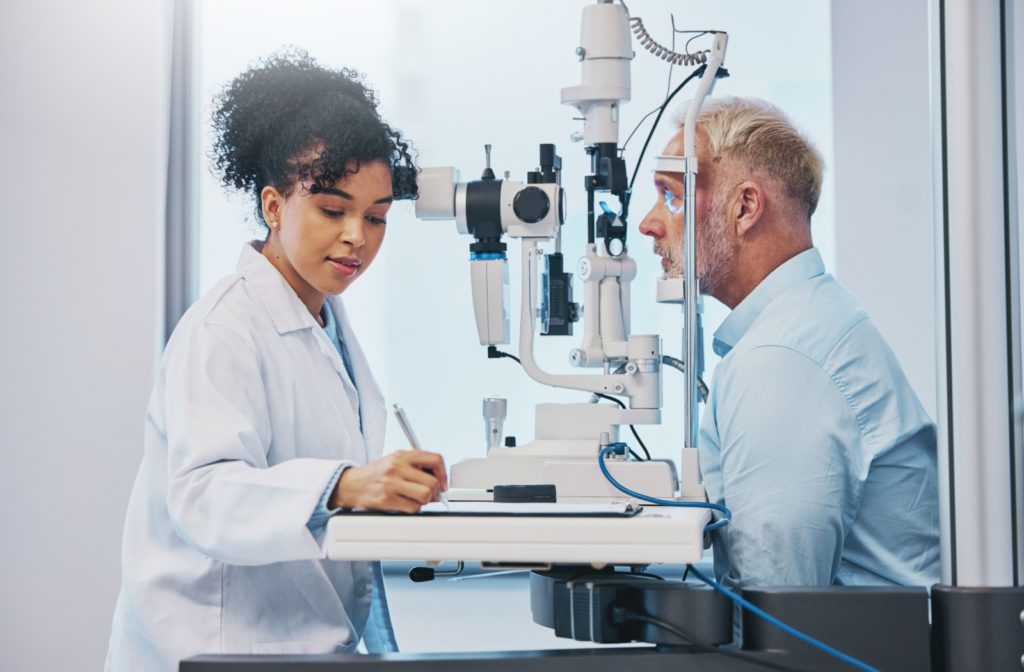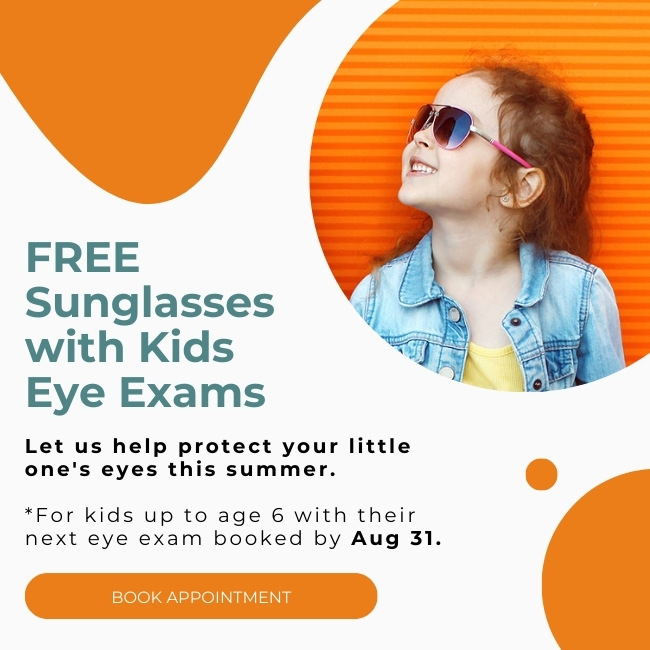A subconjunctival hemorrhage is one of the many possible diagnoses for a sudden-onset red spot on the white of your eye. It happens when a tiny blood vessel breaks just beneath the clear surface of the eye. Some are subtle and some can look very alarming; in all cases it is important to have a red eye checked to confirm the diagnosis as some forms of red eye require urgent care.
Broken blood vessels in the eye can occur for various reasons, such as sudden increases in pressure from sneezing, coughing, or lifting heavy objects, as well as eye rubbing, trauma, certain medical conditions, medications, and environmental or lifestyle factors, especially those factors which cause dry eye.
Understanding the potential causes can help you decide whether it’s worth discussing with your optometrist.
Everyday Causes of Broken Eye Blood Vessels
Broken blood vessels in the eye can occur for several reasons. Often, they result from sudden increases in pressure that strain the delicate vessels. For example, common activities like sneezing, coughing, or lifting something heavy can create enough force to cause a small vessel to rupture. Similarly, vomiting, which exerts significant pressure on your body, can also lead to a broken blood vessel in your eye.
Sometimes, these bursts occur without an obvious cause. You might wake up one morning and notice the red patch, even though you don’t recall doing anything strenuous. These could be related to dry eye, rubbing your eyes during sleep, or occasionally blood diseases.
Eye Rubbing & Trauma
Another frequent cause is physical contact with the eye. Rubbing your eyes, especially if done vigorously or with dirty hands, can damage the small blood vessels. Accidental trauma, such as being struck in the eye or poked while putting on makeup, may also lead to a subconjunctival hemorrhage.
If you wear contact lenses, removing or inserting them improperly can irritate the surface of your eye. This irritation might increase the risk of a blood vessel breaking, particularly if your eyes are already dry or sensitive.
Medical Conditions & Medications
Certain medical conditions can make blood vessels in the eyes more prone to breaking. High blood pressure, for instance, can put stress on the vascular system, including the tiny vessels in your eyes. Similarly, blood-clotting disorders, and conditions that thin the blood may make it easier for these vessels to rupture.
Medications such as blood thinners, aspirin, or anticoagulants can also contribute to this condition.
Environmental & Lifestyle Factors
Your surroundings and daily habits might also play a role. Dry air, allergens, or exposure to irritants like smoke, or prolonged screen use can lead to eye irritation that prompt you to rub your eyes more frequently, causing subconjunctival hemorrhages.
Sleep deprivation or excessive alcohol consumption may weaken your body’s ability to recover from minor injuries, including those affecting your eyes. Maintaining a balanced lifestyle can help support overall eye health.
Are Broken Eye Blood Vessels Serious?
In most cases, a broken blood vessel in the eye is harmless and resolves within 1–2 weeks.
Occasionally, a subconjunctival hemorrhage could indicate a more serious condition. For example, if it’s associated with trauma to the head or eye, it may require immediate attention to rule out more significant injuries. Similarly, frequent hemorrhages (more than one every 6-12 months) might signal a systemic issue, such as uncontrolled hypertension or a blood disorder, that warrants further investigation.
In such cases, or if it’s accompanied by other symptoms like pain, changes in vision, or recurrent episodes, it’s important to visit your optometrist for a thorough evaluation and appropriate care.
Preventing Broken Eye Blood Vessels

While not all cases are preventable, there are steps you can take to reduce the likelihood of experiencing a subconjunctival hemorrhage.
Be Gentle with Your Eyes
Avoid rubbing your eyes, and take care when inserting or removing contact lenses. Using a clean, gentle technique can minimize irritation and strain.
Manage Chronic Conditions
If you have high blood pressure or a clotting disorder, work with your healthcare provider to keep it well-controlled. Regular monitoring can make a big difference.
Take Screen Breaks
Follow the 20-20-20 rule to reduce eye strain. Every 20 minutes, look at something 20 feet away for 20 seconds. This habit helps your eyes rest and recover.
Protect Your Eyes
Use appropriate eye protection when working in environments with irritants or during activities that carry a risk of eye injury. Sunglasses, safety goggles, or specialized eyewear can shield your eyes from harm.
Maintain Overall Health
Eating a diet rich in fruits and vegetables, staying hydrated, and getting enough sleep can all support the health of your eyes. You may require a humidifier through the dry Okanagan winters as well.
When to See an Optometrist
It is important to present to your optometrist anytime you notice a red eye, in order to confirm the diagnosis and address your case specifically. At Tutt Street Optometry, we provide thorough and compassionate eye care. Whether it’s a routine exam or a specific concern, our team is ready to help you maintain your vision and eye health.
Remember, your eyes are an important part of your overall well-being. Don’t hesitate to reach out if you have questions or need support. Contact us to book an appointment today.




